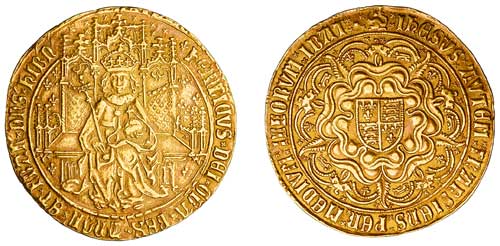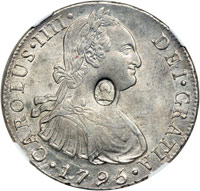
PREV ARTICLE
NEXT ARTICLE
FULL ISSUE
PREV FULL ISSUE
SOME COIN REFERENCES IN SHERLOCK HOLMES
The Fourth Garrideb blog has also been publishing excerpts from The Diogenes Club, originally published in 2016. Here's an
excerpt-of-an-excerpt from the February 6, 2016 issue which mentions some interesting British coins and coin phrases. Be sure to read the
complete article online. -Editor
There is also a reference in this story to “taking the Queen’s shilling,” a phrase which meant to join the army. It was customary for British Army recruiting officers to present a shilling to each new recruit. 
Testoon. Henry VII The shilling, a silver coin often called a “testoon” (from the Italian testa for head) at the time of its origin, was introduced by Henry VII. Henry was the first of the Tudor line (late fifteenth century), an able ruler who succeeded in the task of repairing the damage caused by the Wars of the Roses. He took great interest in the nation’s coinage, also introducing the sovereign, a magnificent new gold coin with Biblical texts around the edge to discourage clipping. Henry VII also went back to the profile view of the monarch on the obverse of the coins, after 300 years of full-face depictions. As the Greeks and Romans had understood a millennium and a half before, the profile portrait looks and wears better on a coin than does the full-face portrait. In Silver Blaze, we learn that Straker had five sovereigns in gold in his pockets when he was found dead on the moor, and in The Greek Interpreter, five sovereigns were paid to Mr. Melas for interpreting. After her wedding to Godfrey Norton, Irene Adler gives a disguised Holmes a sovereign for being a witness, and there are similar references in at least three other stories. 
Sovereign. Henry VII. 1485-1509 During the reign of George III, coins became extremely scarce due to the wars (American Revolution and Napoleonic War), and due to a scarcity of gold, silver, and, later, copper. At the same time, more coins were needed due to the industrial revolution. In the country, people made do with the barter system and had little need for money, but increasing industrialization caused migration to cities, where money was required to pay wages and purchase goods.
“The bank, to make their Spanish dollar pass Stamped the head of a fool on the head of an ass.” To read the complete article, see:
THE BOOK BAZARREWayne Homren, Editor The Numismatic Bibliomania Society is a non-profit organization promoting numismatic literature. See our web site at coinbooks.org. To submit items for publication in The E-Sylum, write to the Editor at this address: whomren@gmail.com To subscribe go to: https://my.binhost.com/lists/listinfo/esylum All Rights Reserved. NBS Home Page Contact the NBS webmaster 
|
